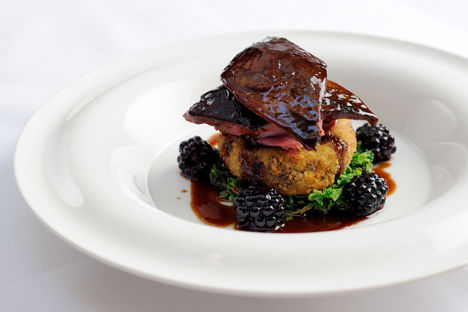
7 glorious grouse recipes for the Glorious Twelfth
August marks the start of game season, with The Glorious Twelfth (August 12) the first day grouse can be hunted. Here’s how to make the most of this magnificent game bird if you can get your hands on one.
7 glorious grouse recipes for the Glorious Twelfth
August marks the start of game season, with The Glorious Twelfth (August 12) the first day grouse can be hunted. Here’s how to make the most of this magnificent game bird if you can get your hands on one.
Grouse season is upon us. 12 August is known as the ‘Glorious Twelfth’ and marks the official start of Britain’s 121-day grouse hunting season. Considered to be the king of game birds, red grouse are unique to Britain and highly prized. They represent the ultimate test of shooting skill, as they can fly at speeds of up to seventy miles per hour, often fly close to the ground, and can change direction in the blink of an eye. Understandably, the red grouse is a well-respected bird; it was the mascot of Scotland’s national rugby team, and is the current emblem of the well-known whisky brand.
All red grouse are wild and are never farmed or reared for hunting (like partridges and pheasants). Their heather moorland habitat is carefully controlled and managed by teams of gamekeepers, who try to maximise the size of the bird population each year. This is done by a process of burning selected patches of heather in a rotation system in order to control its growth and optimise its height. The tradition of the Glorious Twelfth dates back to the Victorian era and coincides with the advent of railways, which enabled hunters to access the northernmost parts of the country far more quickly and easily.
Fresh grouse is sought after due to its rich gamey flavour (it’s also low in fat and high in protein). The country’s top restaurants will fiercely compete for the honour of serving the freshest birds, shot on the very first day of the season. If you don’t fancy going out for some grouse, then good butchers will begin to get grouse in their shops a few days after the first shoot for you to cook at home. Take a look at seven of our most glamorous grouse dishes, which feature both traditional and innovative ways of preparing this famous bird.
1. Roast grouse with game chips, watercress and bread sauce
Thick, creamy bread sauce and crunchy homemade game chips (essentially thick-cut crisps) are traditional accompaniments to grouse for good reason – the flavours are subtle enough to allow the bird to shine, yet they provide a nice range of textures to complement the meat. Fresh watercress adds a peppery bite and a splash of colour. This is the most traditional way of cooking and serving grouse, so if you’re looking for a classic example of British game, this is the recipe to go for.
2. Roast grouse with braised cabbage, celeriac purée and sauce Albert
For a grouse dish that celebrates seasonal autumnal vegetables as much as the grouse itself, try this brilliant recipe from Martin Wishart. Braised savoy cabbage and celeriac purée provide robust autumn flavours, whilst the horseradish and mustard in the Albert sauce (an English classic) add a powerful, punchy finish.
3. Mousseline of grouse with pearl barley, savoy cabbage, pancetta and red wine
Had your fill of roast grouse and want something that’ll really knock the socks off your guests? Try Phil Howard’s stunning grouse mousseline enriched with cream. Supporting acts come in the form of an intense red wine sauce, nutty pearl barley, crisp pancetta and a mix of trompette mushrooms and savoy cabbage.
4. Roast grouse with blackberries and port wine jus
If you’re cooking grouse in August then it’s likely the bird will be younger than those shot later on in the year, which means it will have a more tender texture and subtler flavour. It also means blackberries should be at the peak of their season, so it makes perfect sense to pair the two together, as William Drabble does in this recipe. The sweet sauce is enhanced with port, while the potato galette is a very special way of preparing the potato accompaniment.
5. Pine-scented grouse with cobnuts, haggis, neeps 'n' tatties
Grouse’s deliciously gamey taste means it can stand up to other strong flavours, which makes it a perfect partner for haggis. This distinctly Scottish way of serving the bird also includes neeps and tatties, cobnuts, chard and spelt, with juniper berries and Douglas fir pine adding their aromatic flavours. The grouse itself is cooked sous vide for a particularly succulent finish, before being pan-fried in butter to crisp up.
6. Roast Yorkshire grouse with creamed root vegetables, stuffed cabbage and elderberries
A little later on in the grouse shooting season, elderberries are at their best, too – and there's no better pairing. The rich meat contrasts beautifully with the fruitiness of the elderberry sauce in this recipe, with creamed root vegetables and grouse offal accompanying both.
7. Yorkshire grouse with sweetcorn, black pudding and greengages
Grouse, greengages and sweetcorn all come into season at the same time, and also happen to work incredibly well together. Paired with delicious black pudding and an intense game jus, this dish is a more modern take on cooking a very traditional bird.


